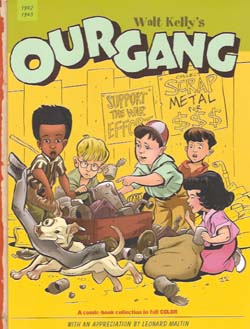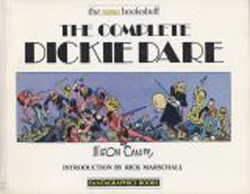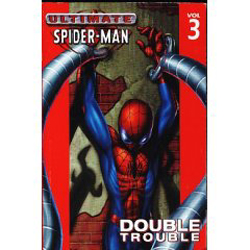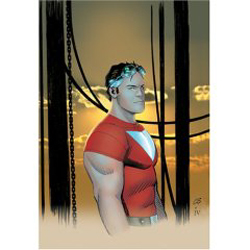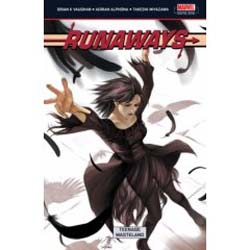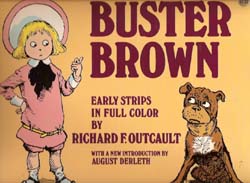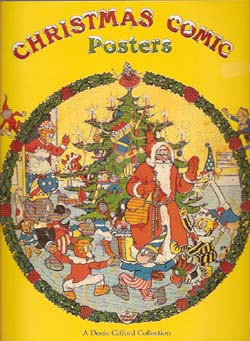MR. PUMP’S LEGACY
Part 1 of THE STRATOSHIP H.22
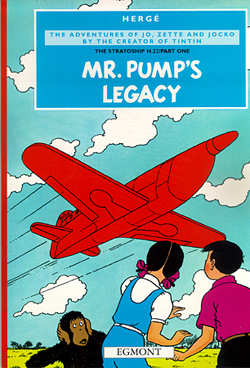
By Hergé, translated by Leslie Lonsdale-Cooper & Michael Turner (Egmont UK)
ISBN 13: 978-1-4052-1245-8
George Remi, world famous as Hergé, had a long creative connection to Catholicism. He had created Tintin at the behest of the Abbot Norbert Wallez, editor of the Catholic newspaper Le XXe Siécle, before moving on to such strips as the mischievous ‘Quick and Flupke’, ‘Tim the Squirrel in the Far West’, ‘The Amiable Mr. Mops’, ‘Tom and Millie’ and ‘Popol Out West’, all while continuing the globe-trotting adventures of the dauntless boy reporter and his faithful dog.
In 1935, between working on The Blue Lotus and The Broken Ear he was approached by Father Courtois, the director of the French weekly newspaper Coeurs Vaillants (‘Valiant Hearts’). The paper already carried Tintin, but Courtois also wanted a strip that would depict the solid family values and situations that the seemingly orphaned boy reporter was devoid of. He also presumably wanted something less subversive than the mischievous, trouble-making working-class boy rascals ‘Quick and Flupke’.
He needed a set of characters that would typify a good, normal family: A working father, a housewife and mother, young boy, a sister, even a pet. Apparently inspired by a toy monkey called Jocko, Hergé devised the family Legrand. Jacques was an engineer, and his son Jo and daughter Zette were average kids; bright, brave, honest, smart and yet still playful. Mother stayed home, cooking and being concerned a lot, and they had a small, feisty monkey for a pet – although I suspect as Jocko was tailless, he might have been a baby chimpanzee, which “As Any Fule Kno†is actually a species of ape.
The first adventure was ‘The Secret Ray’ which is not currently available in English. A ripping yarn of scientific bandits, gangsters, mad professors, robots and, regrettably, some rather ethnically unsound incidences of cannibal savages, this is very much a product of its time in too many respects. Although Hergé came to deeply regret (and wherever possible amend) his many early uses of that era’s racial stereotyping, the island dwelling natives in Le “Manitoba†Ne Répond Plus and L’ Éruption Du Karamako (which first ran in Coeurs Vaillants from January 19th 1936 to June 1937) will now always be controversial.
It’s a true pity that such masterful and joyous work has to be viewed with caution, read strictly in context and be ascribed subtext and values that simply weren’t intended, merely because the medium is pictorial and its meaning passively acquired rather than textual, and which can therefore only be decoded by the conscious effort of reading. I also wonder how much was a quiet, sensitive artist led by an aggressively proselytising, missionary Church’s doctrine and policy… How much Church opposition was there to Mussolini’s invasion of Ethiopia in October 1935 for example? And don’t get me started on Nazi Germany and the Vatican…
‘Mr. Pump’s Legacy’ is much less culturally and commercially troublesome. When septuagenarian millionaire-technocrat, speed-fiend (that’s velocity, not pharmacology) and adrenalin junkie John Archibald Pump, the “American Collar-Stud King†dies in a car crash (at 155 mph, so he probably went surprised but happy) he leaves a ten million dollar prize: The first person or persons to fly non-stop between New York and Paris at an average speed of 1000 kilometres per hour will secure said cash. But if nobody wins within one year the money will revert to his ne’er-do-well nephews.
The contest captures world imagination in the Age of Speed, and many try for the prize, including S.A.F.C.A., the aeronautical company that Jacques Legrand works for. Very soon both the engineer and his family become the targets of skulduggery and sabotage as his groundbreaking design gradually becomes a beautiful flying machine. Assaults, poison-pen letters and threats, murder attempts, blackmail and even kidnapping, nothing can stop the project whilst the canny Jo and Zette are there to foil them. Even when the completed plane is targeted by an aerial bombardment, the resourceful children have a solution. Starting the plane, they fly away from the bomber, but become lost in the night and clouds.
With their fuel almost exhausted they spot a tiny island in a vast sea and manage to land the plane safely. How can they return the ship in time to win the Prize? Without food, water, fuel or any idea where they are, can they survive long enough to be found?
Combining all-ages thrills and slap-stick comedy with magical art and superb designs, the masterful Hergé, a creator rapidly reaching the peak of his powers, has produced in this cliff-hanging volume of adventure a lost classic, and one worthy of much greater public attention. With Christmas looming it could be the best £6.99 you’ll spend this year…
© 1951, 1979, 2007 Editions Casterman, Paris& Tournai. All Rights Reserved.
English text © 1987, 2005 Egmont UK Limited. All Rights Reserved.
